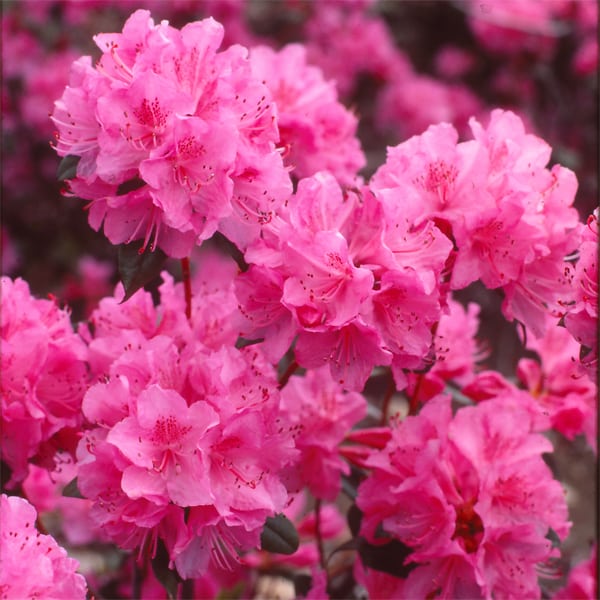Back in the 1940’s my dad Ed Mezitt had a dream—offering a better selection of early-flowering plants well-adapted to tolerate this region’s weather extremes. His first hybridizing attempt turned out to be unbelievably fortuitous: it resulted in the now-ubiquitous (in a good way!) Rhododendron ‘PJM’!
Developed and introduced right here in Hopkinton, ‘PJM’ has become world renown, and rightfully so. Few woody plants thrive or even tolerate the harsh conditions it does, and not many offer such a stunning display of early spring color, as well as distinctive winter appeal. It truly sets the performance standard for Zone 5 and colder landscapes.
And once Ed realized how outstanding his ‘PJM’ actually was, he used it as a basis for developing a plethora of new cultivars with an increasingly wide range of flower and foliage colors and different growth habits. Ed spent the last decades of his life hybridizing, selecting and introducing these exciting Early Rhododendrons we now enjoy.
To be termed an “Early Rhododendron”, the plant is expected to reliably display its blooms each year in early spring, at the latest by Mother’s Day here in Hopkinton. Very few of the large leaf rhododendrons open their flowers so early in the season, and most Early Rhododendrons are the small leaf kinds, like PJM.
But these plants are not all PJM’s – in fact many have entirely separate parentage, and consequently offer many different flower color, foliage and forms for your garden enjoyment. In addition to ‘PJM’, here are some of the Early Rhododendrons currently available, all developed at Weston Nurseries, listed in order of their blooming times:
- ‘Weston’s Pink Diamond’. Fluffy double-pink flowers opening a week or more earlier than ‘PJM’. Colorful autumn foliage;
- ‘April Snow’. Double-flowering white with pungently-fragrant green leaves all year, and yellow winter stems;
- ‘Checkmate’. Low growing and compact form of the lavender-pink flowering ‘PJM’;
- ‘Blue Baron’. Brilliant near-blue flowers, tiny elongated green foliage turns bronzed for the winter. Less winter-tolerant than other Weston introductions; be sure to plant it in a protected location;
- ‘Molly Fordham’. Near-white flowers, leathery dark green foliage;
- ‘Landmark’. Large trusses of dark pink flowers appear red from a distance. Large leathery green leaves change to bronze-mahogany for winter;
- ‘Olga Mezitt’. Clear pink flowers, shiny bright green aromatic leaves turn dark bronzy copper as winter approaches. Chosen as a Cary Award Winner for 2007 (see www.CaryAward.com);
Unlike their large-leaf relatives, most of the Early Rhododendrons (excepting ‘Blue Baron’) thrive in open, exposed locations, even in colder parts of New England. Although they produce smaller size flowers, their hardiness, profusion of bloom and their tendency for even young plants to produce impressive displays more than compensates. People sometimes mistake them for evergreen azaleas, few of which perform so consistently in our harsh New England winters.
Be sure to choose a sunny planting location with well drained acid soil, and a high organic content. None of the Early Rhododendrons will perform well with “wet feet”, and they can suffer in boggy conditions. All require minimal fertilizing, and they readily tolerate shearing to maintain their size and shape – it’s best to cut them back right after they finish flowering. Try placing them near a walkway or path where their aromatic leaves can add to your enjoyment any time of year as you brush by.
The Early Rhododendrons are becoming increasingly available at garden centers in this region. But shop early–those who wait for warmer weather often miss seeing them because they’ve finished flowering by the time “real” spring begins.







